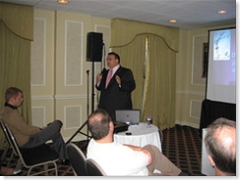 Charles Pizzo’s hands-on workshop provided participants with a checklist for internet newsrooms.
Charles Pizzo’s hands-on workshop provided participants with a checklist for internet newsrooms.
He started by pointing out that newsrooms should make life easy for reporters. So, the navigation buttons and links should appear on every page in order to make navigating the site simple and quick.
The newsroom should be designed for journalists on deadline. One thing that too many newsrooms bury is the basic facts on the company. Reporters will need to check these facts for updates with every filing. So, they should be no more than one click away.
Some basic rules:
- Content should be updated 24/7
- Clear writing
- Include ghost pages that can be filled in with crisis information when it becomes necessary
- The newsroom should be mirrored offsite to ensure that information continues to be available and can be updated in the event of a disaster
- Writing should be clear.
Corporate blogs and blogs should be interlinked with the newsroom. The blog allows for dialogue which has traditionally not been readily available in newsrooms. This information will now become part of the hard (factual) and soft (feelings, impressions) information that reporters will use in their research.
Newsrooms should be optimized for search engines. This is even more important in the era of blogs. As blogs rise to the top of search engine results, they are pushing corporate newsrooms down the list of search engine results.
RSS feeds should enable reporters to subscribe to streams of information that reflects their interests.
There should be one click access to the newsroom on the corporate website home page.
The most common mistake on net newsrooms is to provide the most basic information. Who we are. What we do. Some reporters would like 25 word and 5 word versions of the company descriptor.
Contact data should be prominently displayed in the newsroom and on the releases section. Mark media contact numbers clearly as “For media inquiries only.” Also post numbers for people looking for other contacts (e.g. accounting; customer service; central switchboard.)
Ensure that dates permanently appear at the top of all news releases in the archive.
Embed links in online releases. Use bullet points to ensure that reporters can scan quickly.
Provide links to “printer friendly” versions of all pages and releases.
Companies operating in a technical or specialized area should include “glossaries” of terms and acronyms.
Don’t be afraid to correct misinformation on your newsroom. Coca Cola actually has a “Myths and Rumors” section that provides authoritative information.
Most importantly, ensure that the newsroom has a Search bar.
Mix text and art in news releases to enhance readability and provide essential information. (What’s worth 1,000 words?)
Design the newsroom page to be scroll free. The entire page should be viewable without having to scroll down for additional content.
Newsrooms should contain in-depth information beyond news releases. Links to corporate responsibility; environmental policies; code of ethics, etc.
A FAQs page should contain responses to issues and questions that are topical.
Artwork should be posted in high and low resolution (printable) versions, along with corporate videos (e.g. quarterly results) and B-roll videos.
Post positions papers, white papers, presentations and research to reporters to download and use.
Finally, include a Feedback form to enable reporters to tell you what they liked and didn’t like, what they would like you to add or change.
Charles’ complete set of slides can be downloaded from www.charlespizzo.com/pr06.
